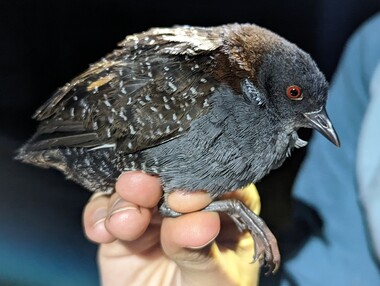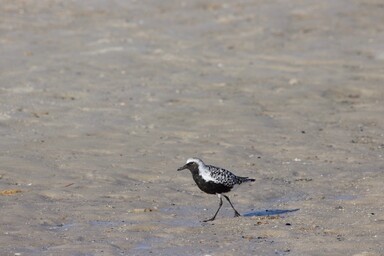 Avian Biologist Heather Levy holding an Eastern Black Rail. Photo by Nick Asreen.
Contributed by Heather Levy
The search for North America’s most secretive bird is in full swing in the Florida panhandle! Eastern Black Rails act more like a mouse than a typical bird. They spend most of their lives hidden underneath thick wetland vegetation and rarely fly or call. Because of their secretive nature, many aspects of their life history are poorly understood.
Found mainly on the Atlantic and Gulf coasts, Eastern Black Rails also have populations in a few interior states. They use a variety of marsh types, including both fresh and saltwater, but have specific needs when it comes to plant cover. They need vegetation that is thick enough above to provide protection, but more open lower down so they can move about easily. They also don’t like getting their feet wet and only tolerate a few centimeters of water. Occurring year round in Florida, Eastern Black Rails are usually found in high marshes, an environment located between the low marsh and the uplands where flooding is rare. Although Eastern Black Rails are difficult to study, surveys across the past few decades show a steep population decline of nearly 70% across their range. In 2020, they were listed as federally threatened under the Endangered Species Act.
In addition to sea level rise and development, Eastern Black Rails face threats from habitat loss due to mismanagement. Fire suppression can let woody shrubs overtake the high marsh, shrinking the more open, grassy areas these birds need. That’s where the Firebird Project comes in. This NOAA RESTORE Science funded project aims to assess both the distribution of EBLRAs in high marshes and how prescribed fire application affects the birds and their habitats. The Stoddard Bird Lab at Tall Timbers Research Station and Land Conservancy are working in the Florida Fish and Wildlife Conservation Commission’s Big Bend Wildlife Management Area to determine where Eastern Black Rails occur, characteristics of the habitat they are using, and how prescribed fire influences “occupancy”, the chance of detecting a bird.
Throughout the year, staff members of the Stoddard Bird Lab conduct surveys of Eastern Black Rails and the habitat they are in. Fieldwork is still underway, but so far, we’ve learned that a two-to-five-year interval between fires seems to provide the best habitat. The Florida panhandle still supports a relatively strong population of Eastern Black Rails, but there has likely been a decline from historic numbers. The results of this multi-year project will help inform management decisions made to conserve this rare species.
While Eastern Black Rails are on many birders ‘wanted’ lists, they need to be observed with care. Since these birds are federally listed, using playback to entice them is illegal. Trampling through the marsh is destructive and directly harms individuals and nests. However, there are ways to observe (well, mostly listen) to them ethically. Study up on their preferred habitat, go during dawn or dusk when they are active, and be prepared to wait. It is well worth fighting through the biting gnats and mosquitoes to hear the call of these mysterious and rare birds!
Heather Levy is an avian biologist at Tall Timbers Research Station and Land Conservancy. She oversees logistics and leads surveys for the Firebird project in the state of Florida.
 A Black-bellied Plover at Perdido Key on the Gulf Island National Seashore. Photo by Travis Blunden.
The shores of Pensacola are packed with “Great” birding destinations, especially during spring and fall migration. One of them is the Perdido Key Unit of Pensacola’s Gulf Islands National Seashore, a narrow, undeveloped peninsula that provides a haven for breeding shorebirds and migrants seeking the first stretch of land after a long flight. Find them in the pinewoods north of the parking lot by exploring the 0.5-mile boardwalk loop and keep an eye out for Clapper Rails at the muddy edges. Afterwards, head towards the beach facilities and take the road west for the shorebirds. Perdido Key stretches for miles of pale sand with dunes on one side and beach on the other. Use the pullover spots along the road to hop out and stroll the beach where you’ll find Sandwich, Least and Royal Terns, Black-bellied Plovers, Sanderlings and more.
On the other side of the road you’ll find protected dunes where Least Terns nest. See them from the roadside or from the boardwalk that crosses the nesting area. Watch the parent terns flit through the air and plunge into the lagoon as they fish before carrying their spoils back to hungry chicks, well camouflaged in the sand. Across the water is Big Lagoon State Park, a Great Florida Birding and Wildlife Trail Gateway site that’s an easy addition to a day trip in the area. Speak to the rangers there to get a free Great Florida Birding and Wildlife Trail guidebook and look for Ospreys, pelicans and other birds crossing between Perdido Key and the mainland.
Check out the Perdido Key park website to get information on entrance fees, park rules and more. See the eBird list here.
|